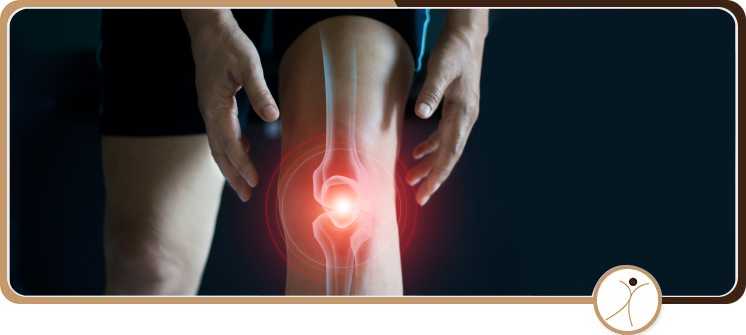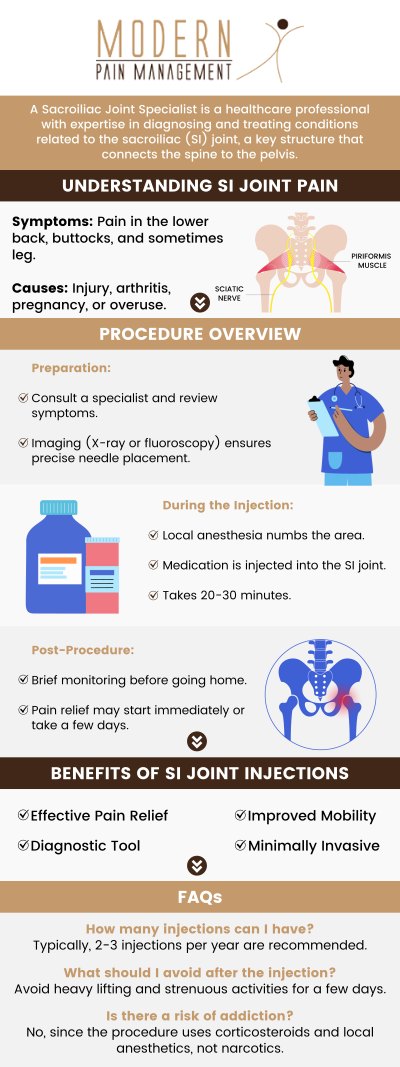Is Your SI Joint Causing Hip Pain?
Are you experiencing hip pain that just won’t go away? It could be your Sacroiliac (SI) joint at the root of the issue. At our clinic, we specialize in diagnosing and treating SI joint problems to provide relief and restore functionality. Discover how our tailored treatments can alleviate your discomfort and improve your daily life. Take the first step towards a pain-free future today. Consult Dr. George Atallah, D.O., and our dedicated team for guidance and personalized care in addressing your SI joint pain. For more information, please contact us or book an appointment online. We have convenient locations to serve you in Houston, TX, and Sugar Land, TX.




Table of Contents:
Can sacroiliac joint dysfunction cause hip pain?
What are the symptoms of chronic sacroiliac joint pain?
Can hip arthritis affect the SI joint?
What treatments are available for SI joint pain at Modern Pain Management?
Yes, SI joint pain can cause pain and stiffness in the hips. The SI joint, located where the lower spine and pelvis meet, plays a critical role in transferring weight between the upper body and the legs. When this joint is not functioning properly, it can lead to pain and discomfort that may radiate to surrounding areas, such as the hips, lower back, buttocks, and groin.
If you’ve noticed such symptoms, you may be experiencing SI joint dysfunction. Furthermore, keep in mind that other conditions can mimic the symptoms of SI joint dysfunction, such as arthritis, hip bursitis, sciatica, and lumbar spine disorders. Due to this, seeing a specialist is essential for receiving an accurate diagnosis as to what is causing your hip pain.
Chronic SI joint dysfunction can lead to a variety of symptoms, including:
• Lower back pain – Most commonly, SI problems cause pain in the lower back that can range from a dull discomfort to a sharp, excruciating sensation.
• Radiating pain – The pain caused by SI joint dysfunction can radiate to the hips, groin, legs, and even the feet. Although SI joint pain is often felt on one side, it can affect both sides in some cases.
• Stiffness – Chronic SI joint dysfunction can cause stiffness in the lower back, hips, and pelvis, limiting the range of motion and flexibility. Due to this, SI pain can make bending, twisting, or getting up from a seated position more difficult and painful.
• Altered gait – As a result of discomfort, it’s common for patients affected by SI pain to develop an altered gait or limp. Furthermore, chronic SI dysfunction can result in changes in posture.
Yes, hip arthritis can put biomechanical stress on the SI joint, resulting in a restricted range of motion and SI joint degeneration. Hip arthritis can cause changes in the way you move and bear weight. As the hip joint degenerates and becomes painful, you may unconsciously shift your weight to the SI joint, leading to wear and tear over time.
A common consequence of increased stress on the SI joint is inflammation, which worsens the pain and contributes to limited mobility. If you have hip arthritis and start experiencing pain or discomfort in your lower back, buttocks, or pelvis, it is important to speak with a pain management doctor regarding the possibility of SI joint dysfunction.
By working with a reputable pain management professional, you can successfully manage the symptoms of hip arthritis or SI joint problems. The specialist will employ various diagnostic tools to determine what’s behind your symptoms and create a comprehensive management plan to prevent your condition from drastically affecting your wellness.
The skilled professionals at Modern Pain Management offer a variety of approaches to managing SI joint problems, such as:
• Medications – Depending on your specific symptoms, your physician may prescribe nonsteroidal anti-inflammatory drugs (NSAIDs), muscle relaxers, or disease-modifying antirheumatic drugs (DMARDs) to address muscle spasms, inflammation, and other issues caused by SI joint dysfunction.
• Physical therapy – Strengthening exercises and certain stretches are beneficial for enhancing the range of motion in the lower back and hips.
• Corticosteroid injections – To address swelling and pain, your pain management specialist may administer corticosteroid injections into the affected joint.
• Radiofrequency denervation – If your discomfort is a result of a pinched nerve, radiofrequency denervation can be used to destroy the nerve and alleviate pain.
• Electrical stimulation – In some cases, implanting an electrical stimulator in the lower spine is recommended to address symptoms caused by sacroiliitis.
In addition, your healthcare provider can offer guidance on home care, such as what movements to avoid and how to use ice therapy to reduce your symptoms. For comprehensive support in managing SI pain, schedule your visit to Modern Pain Management in Houston or Sugar Land, Texas.
Achieve lasting relief and regain your quality of life with our specialized treatments at Modern Pain Management. Schedule your consultation today and discover how our compassionate team can help you overcome SI joint pain effectively. Join countless others who have found comfort and improved mobility under our care. For more information, please contact us or book an appointment online. We have convenient locations to serve you in Houston TX and Sugar Land TX. We serve patients from Houston TX, Sugar Land TX, Pearland TX, Jersey Village TX, Missouri City TX, Stafford TX, and Richmond TX.
ADDITIONAL SERVICES YOU MAY NEED




